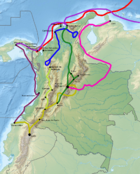Gonzalo García Zorro
- Diego Alonso El Zorro (father)
- Teresa González de Sancha (mother)
Unnamed (sister)
1544–1545
1545–1546
1548–1548
1550–1551
1553–1554
1556–1556
1564–1564
Gonzalo García Zorro (c. 1500 – 1566) was a Spanish conquistador who participated in the Spanish conquest of the Muisca people. García Zorro was encomendero (mayor) of Santa Fe de Bogotá for seven terms, and received the encomiendas of Fusagasugá and Fosca.
He married three times, twice with Muisca women, and had one daughter, Francisca, and a son, Diego. García Zorro died of wounds he suffered in a duel with Alonso Venegas. Venegas was the son of fellow conquistador Hernán Venegas Carrillo and the grandson through his mother of Sagipa, the last zipa (leader) of the Muisca, whom García Zorro had helped to kill.
Knowledge of the life of García Zorro comes from the works Elegías de varones ilustres de Indias (1589) and El Carnero (1638), by Juan de Castellanos and Juan Rodríguez Freyle respectively.
Biography
Gonzalo García Zorro was born around 1500 in Guadalcanal, at the border between Extremadura and Seville.[2] His parents were Teresa González de Sancha and Diego Alonso El Zorro. Gonzalo García Zorro had a brother, Antonio, and a sister.[1]
García Zorro joined the expedition led by Gonzalo Jiménez de Quesada from Santa Marta towards the Muisca Confederation in April 1536 as a cavalry leader.[3][4][5] García Zorro was later convicted of crimes against the last zipa, Sagipa.[6]
Gonzalo García Zorro was seven times encomendero of Santa Fe de Bogotá: in 1544 succeeding Juan Ruiz de Orejuela, who succeeded García Zorro again; from 1545 to 1546, succeeding the second term of Juan Ruiz de Orejuela and preceding Juan de Céspedes; in 1548 between the reign of Juan Muñoz de Collantes and the third term by Juan Ruiz de Orejuela; from 1550 to 1551 in between the terms of Juan de Avellaneda; between 1553 and 1554 succeeding Juan de Rivera and preceding Juan Tafur; in 1556 between the terms of Antonio Ruiz and Domingo Lozano; and finally in 1564 succeeding Juan Ruiz de Orejuela again and preceding Andrés de Molina.[7]
Gonzalo García Zorro received the encomiendas of Fusagasugá,[3][8] and Fosca.[9] The encomienda of Suesca was shared between Gonzalo García Zorro and Juan Tafur.[10]
Gonzalo García Zorro died in 1566 at Santa Fe de Bogotá of wounds he received in a duel with Alonso Venegas. Venagas was the son of Magdalena de Guatavita, daughter of Sagipa, and Hernán Venegas Carrillo.

See also
- List of conquistadors in Colombia
- Spanish conquest of the Muisca
- Hernán Pérez de Quesada, Hernán Venegas Carrillo
- Gonzalo Jiménez de Quesada
References
- ^ a b Gonzalo García Zorro – Geni
- ^ a b (in Spanish) Gonzalo García Zorro – Banco de la República – Soledad Acosta de Samper
- ^ a b Acosta, 1848, p.399
- ^ De Piedrahita, 1676, p.102
- ^ (in Spanish) Lista de los que consiguieron el descubrimiento del Reino de Granada con el General don Gonzalo Jiménez de Quesada, en el año de 1538 Archived 2016-03-09 at the Wayback Machine – Banco de la República
- ^ Ocampo López, 1996, p.55
- ^ (in Spanish) List of mayors of Bogotá – 1538–1599
- ^ (in Spanish) Los caballeros de la conquista
- ^ De Castellanos, 1589, p.418
- ^ Rodríguez Freyle, 1638, p.112
Bibliography
- Acosta, Joaquín. 1848. Compendio histórico del descubrimiento y colonización de la Nueva Granada en el siglo décimo sexto – Historical overview of discovery and colonization of New Granada in the sixteenth century, 1–460. Beau Press. Accessed 2017-03-06.
- De Castellanos, Juan. 1857 (1589). Elegías de varones ilustres de Indias, 1–567. Accessed 2017-03-06.
- Fernández de Piedrahita, Lucas. 1676. VI. Historia general de las conquistas del Nuevo Reino de Granada. Accessed 2017-03-06.
- Ocampo López, Javier. 1996. Leyendas populares colombianas – Popular Colombian legends, 1–384. Plaza y Janes Editores. Accessed 2017-03-06.
- De Plaza, José Antonio. 1810. Memorias para la historia de la Nueva Granada desde su descubrimiento el 20 de julio de 1810, 1–464. Imprenta del Neo-Granadino. Accessed 2017-03-06.
- Rodríguez Freyle, Juan, and Darío Achury Valenzuela. 1979 (1859) (1638). El Carnero – Conquista i descubrimiento del nuevo reino de Granada de las Indias Occidentales del mar oceano, i fundacion de la ciudad de Santa Fe de Bogota, 1–592. Fundacion Biblioteca Ayacuch. Accessed 2017-03-06.
Further reading
- Jiménez de Quesada, Gonzalo. 1576. Memoria de los descubridores, que entraron conmigo a descubrir y conquistar el Reino de Granada. Accessed 2017-03-01.
- Simón, Pedro. 1892 (1626). Noticias historiales de las conquistas de Tierra Firme en las Indias occidentales (1882–92) vol.1–5. Accessed 2017-03-01.
- N, N. 1979 (1889) (1539). Epítome de la conquista del Nuevo Reino de Granada, 81–97. Banco de la República. Accessed 2017-03-01.
- v
- t
- e
Topics | |||||||
|---|---|---|---|---|---|---|---|
| |||||||
Geography and history | |||||||||||||
|---|---|---|---|---|---|---|---|---|---|---|---|---|---|
| |||||||||||||
Religion and mythology | |||||||||||||||
|---|---|---|---|---|---|---|---|---|---|---|---|---|---|---|---|
| |||||||||||||||
Caciques and neighbours | |||||||||||||||||||||||
|---|---|---|---|---|---|---|---|---|---|---|---|---|---|---|---|---|---|---|---|---|---|---|---|
| |||||||||||||||||||||||
| ||||||||||
Research and collections | |||||||||
|---|---|---|---|---|---|---|---|---|---|
| |||||||||
 Category
Category

















